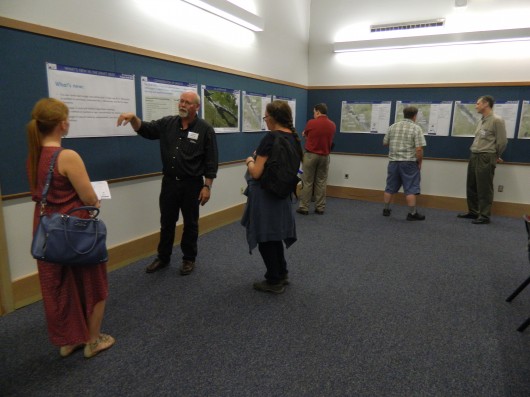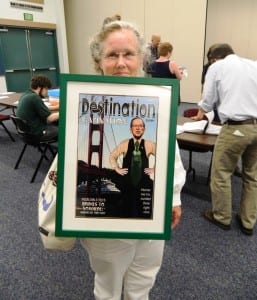
John Barnett of the Alaska Department of Transportation answers questions during the Gravina Access Project open house.
The Alaska Department of Transportation is collecting public comments about the state’s newest set of options for how to improve access to Ketchikan’s Gravina Island.
Members of the public can submit comments on the newest Gravina Access study through a variety of methods. A recent public hearing was one way, but written comments will be accepted through the DOT website and via regular mail.
Will those official comments include social media posts? Well. Maybe. During an open house and public hearing in Ketchikan, DOT Southeast Region Director Albert Clough said they’re considering it, and he notes that a post linking to the study has been very popular.
So, how popular? To answer that, he calls over DOT Spokesman Jeremy Woodrow, who said, “We had over 39 Facebook comments and the post was seen by over 13,000 people. It was shared numerous times, but I don’t have the number of shares because I can’t see that on my phone.”
A quick check on Facebook the next morning shows the post was shared more than 30 times.
Why that particular post, and this particular issue, is so popular is open to speculation. But the access project did receive national attention in 2007, when former Gov. Sarah Palin halted plans to build a $400 million bridge to Gravina in response to a national backlash against earmarks. As the vice-presidential candidate the following year, she called it the “bridge to nowhere” in many of her campaign speeches, and five years later, the project still is mentioned by pundits debating federal projects.
The newest study offers two scaled-back bridge options and four ferry plans. Large maps and information about each were pinned to the walls of the Ted Ferry Civic Center, and DOT official John Barnett talked with a small group of local residents about the project.
He notes that the bridge options each cost more up front than any of the ferry plans, but “a bridge, maybe will run you maybe a quarter million dollars over a year to maintain, but the existing ferry right now is $2 million a year. And with a ferry, you’re looking at a ferry replacement every 30-35 years.”
Barnett points to maps of the bridge alternatives. The first, called F3, is a $276-million, two-bridge option that starts south of city limits and spans Pennock Island.
The second is a one-bridge alternative, called C3-4, costing an estimated $223 million to build.
“It starts right at WalMart and comes up behind Wal Mart and goes up on that little bench … and would just shoot across to the airport and right about here it starts to bend down, and ends up right at the rental car agency,” he said.
The ferry options offer new ferries and new terminals at various locations, such as Peninsula Point and The Plaza. All the ferry options include new waiting facilities, restrooms, improved parking and shuttle vans. The initial costs range from $23 million to $81 million.
A handful of residents testified during the public hearing. Most favored a bridge: Any bridge.
Borough Manager Dan Bockhorst stressed the need for easy access to Ketchikan’s airport, which he said is the state’s fifth-busiest. Bockhorst adds that Ketchikan residents should receive the same treatment as other Alaskans, and shouldn’t be charged the proposed $5 toll.
“The Ketchikan Gateway Borough, representing its citizens, wants equal treatment as residents of other communities have with respect to their airports,” he said. “We are in opposition to any prospect of a toll unless similar arrangement applies to every resident of this state.”
Michael Spence, representing the Southeast Alaska Pilots Association, a marine pilots organization, spoke against both bridge options, citing concerns about how such construction would affect marine traffic in the Tongass Narrows. Regarding the F3 option, he talked about increased traffic in the west channel of the narrows, due to the proposed low bridge over the east channel. In addition, Spence said,
“This proposal neglects to state the hazards of introducing so many turns in the approach to Ketchikan’s harbors for very large vessels, and how those turns will be safely executed at times with winds over 20 knots and reduced visibility,” he said.
Spence also estimates that large cruise ships will lose about 30 minutes of port time if they’re forced to travel through the west channel.
He said the proposed design for the C3-4 option provides openings that are too narrow for cruise ships to safely pass through.
Wally Klingelhut spoke strongly in favor of a bridge, and received some spontaneous applause for his comments.
“Any young people here tonight, I hope they don’t have to wait as long as I have,” he said. “When they said the bridge to nowhere, that’s exactly where Ketchikan is going without a bridge: Nowhere.”
Karyle Beitman, who lives on Gravina, also spoke in favor of a bridge, along with Pennock Island residents Renee and Ed Schofield, and Ketchikan City Council Member Dick Coose. South End resident Diana Chaudhary spoke against the F3 alternative, expressing concern about how it would affect her view and property value.
Carol Cairnes also attended the hearing, but didn’t speak. She said her comments wouldn’t fit into the three-minute time limit, so she’s submitting it in writing, instead. She brought along a framed image, though, which she said sums up her comments visually.
“This is a poster. It’s done by Robert Walsh,” she said. “He did this poster of Ted Stevens and it’s essentially a commentary on the Gravina Access Project being the poster child for political corruption.”
Cairnes said she’s concerned with how the bridges would affect not only marine traffic, but floatplanes. Any of the ferry alternatives works for her, but she said the problem with that is Ketchikan doesn’t receive adequate funds from the state for its ferries.
DOT is taking comments on the draft Supplemental Environmental Impact Statement through Aug. 13th. After that, officials will prepare a final SEIS. The department plans to file a Record of Decision by next spring.
To see the study online and for information about how to comment, go to http://dot.alaska.gov/sereg/projects/gravina_access/






